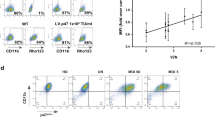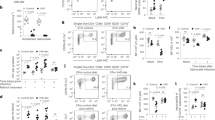Abstract
Macrophages are normal targets for Salmonella during natural infections, and it has been demonstrated that attenuated bacteria can deliver nucleic acid vaccine constructs. Therefore, we assessed if attenuated Salmonella can be used for the in vivo delivery of transgenes to their natural cellular target, in an attempt to correct genetic defects associated with monocytes/macrophages. This system would offer the distinct advantage of achieving a specific targeting of defective cells in a non-invasive form. Using a reporter gene, we demonstrated that attenuated Salmonella could be used as an effective in vitro delivery system to transfer genetic material into nondividing cells like murine macrophages. In vivo, the oral administration of attenuated Salmonella allows targeted delivery of transgenes to macrophages and subsequently expression of transgenes at a systemic level. IFNγ-deficient mice (GKO) were thus selected as a model for the in vivo validation of the Salmonella-based delivery approach. Attenuated Salmonella, used as the carrier for a eukaryotic expression vector encoding the murine IFNγ gene, was able to restore the production of this cytokine in GKO macrophages. Their oral administration to IFNγ-deficient mice also re-established, in these immunocompromised animals, the natural resistance to bacterial infections. These results demonstrate, for the first time, that attenuated Salmonella can be successfully used in vivo as a DNA delivery system for the correction of a genetic defect associated with monocyte/macrophages.
This is a preview of subscription content, access via your institution
Access options
Subscribe to this journal
Receive 12 print issues and online access
$259.00 per year
only $21.58 per issue
Buy this article
- Purchase on Springer Link
- Instant access to full article PDF
Prices may be subject to local taxes which are calculated during checkout




Similar content being viewed by others
References
Malech HL, Bauer TR Jr, Hickstein DD . Prospects for gene therapy of neutrophil defects Semin Hematol 1997 34: 355–361
Meischl C, Roos D . The molecular basis of chronic granulomatous disease Springer Semin Immunopathol 1998 19: 417–434
Platt F, Butters TD . New therapeutic prospects for the glycosphingolipid lysosomal storage diseases Biochem Pharmacol 1998 56: 421–430
Grillot-Courvalin C et al. Functional gene transfer from intracellular bacteria to mammalian cells Nat Biotechnol 1998 16: 862–866
Grillot-Courvalin C, Goussard S, Courvalin P . Bacteria as gene delivery vectors for mammalian cells Curr Opin Biotechnol 1999 10: 477–481
Sizemore DR, Branstrom AA, Sadoff JC . Attenuated Shigella as a DNA delivery vehicle for DNA-mediated immunization Science 1995 270: 299–302
Hackett J . Use of Salmonella for heterologous gene expression and vaccine delivery systems Curr Opin Biotechnol 1993 4: 611–615
Darji A et al. Oral somatic transgene vaccination using attenuated S. typhimurium Cell 1997 91: 765–775
Medina E et al. Salmonella vaccine carrier strains: effective delivery system to trigger anti-tumor immunity by oral route Eur J Immunol 1999 29: 693–699
Paglia P et al. Gene transfer in dendritic cells, induced by oral DNA vaccination with Salmonella typhimurium, results in protective immunity against a murine fibrosarcoma Blood 1998 92: 3172–3176
Jones BD, Falkow S . Salmonellosis: host immune responses and bacterial virulence determinants Annu Rev Immunol 1996 14: 533–561
Jane SM, Cunningham JM, Vanin EF . Vector development: a major obstacle in human gene therapy (editorial) Ann Med 1998 30: 413–415
Robbins PD, Ghivizzani SC . Viral vectors for gene therapy Pharmacol Ther 1998 80: 35–47
Michalski JC, Klein A . Glycoprotein lysosomal storage disorders: alpha- and beta-mannosidosis, fucosidosis and alpha-N-acetylgalactosaminidase deficiency Biochim Biophys Acta 1999 1455: 69–84
Feder JN . The hereditary hemochromatosis gene (HFE): a MHC class I-like gene that functions in the regulation of iron homeostasis Immunol Res 1999 20: 175–185
Nansen A et al. Role of interferon-gamma in the pathogenesis of LCMV-induced meningitis: unimpaired leucocyte recruitment, but deficient macrophage activation in interferon-gamma knock-out mice J Neuroimmunol 1998 86: 202–212
Kjerrulf M et al. Interferon-gamma receptor-deficient mice exhibit impaired gut mucosal immune responses but intact oral tolerance Immunology 1997 92: 60–68
Montosi G et al. Wild type Hfe protein normalizes transferrin iron accumulation in macrophages from subjects with hereditary hemochromatosis Blood 2000 96: 1119–1124
Paglia P et al. The defined attenuated Listeria monocytogenes delta mp12 mutant is an effective oral vaccine carrier to trigger a long-lasting immune response against a mouse fibrosarcoma Eur J Immunol 1997 27: 1570–1575
Guzman CA et al. Attenuated Listeria monocytogenes carrier strains can deliver an HIV-1 gp120 T helper epitope to MHC class II-restricted human CD4+ T cells Eur J Immunol 1998 28: 1807–1814
Dietrich G et al. Delivery of DNA vaccines by attenuated intracellular bacteria Immunol Today 1999 20: 251–253
Dilts DA et al. Phase I clinical trials of aroA aroD and aroA aroD htrA attenuated S. typhi vaccines; effect of formulation on safety and immunogenicity Vaccine 2000 18: 1473–1484
Hone DM et al. A galE via (Vi antigen-negative) mutant of Salmonella typhi Ty2 retains virulence in humans Infect Immun 1988 56: 1326–1333
Levine MM et al. Safety, infectivity, immunogenicity, and in vivo stability of two attenuated auxotrophic mutant strains of Salmonella typhi, 541Ty and 543Ty, as live oral vaccines in humans J Clin Invest 1987 79: 888–902
Russell DW, Hirata RK . Human gene targeting by viral vectors Nat Genet 1998 18: 325–330
Medina E et al. Pathogenicity island 2 mutants of Salmonella typhimurium are efficient carriers for heterologous antigens and enable modulation of immune responses Infect Immun 1999 67: 1093–1099
VanCott JL et al. Regulation of host immune responses by modification of Salmonella virulence genes Nature Med 1998 4: 1247–1252
Onodera M et al. Successful peripheral T-lymphocyte-directed gene transfer for a patient with severe combined immune deficiency caused by adenosine deaminase deficiency Blood 1998 91: 30–36
Bordignon C et al. Gene therapy in peripheral blood lymphocytes and bone marrow for ADA-immunodeficient patients Science 1995 270: 470–475
Bordignon C et al. Cell therapy: achievements and perspectives Haematologica 1999 84: 1110–1149
Acknowledgements
This work was in part supported by grants from Telethon-Italy (Grant Nos A102 and A135), ISS-AIDS-1998, AIRC, CNR (PF-Biotechnology), HGF-Strategiefondsprojekt 98/03 ‘Infektionsabwehr und Krebsprävention’ (P1.3) and the European Community (QLK2-CT-1999–00310).
Author information
Authors and Affiliations
Rights and permissions
About this article
Cite this article
Paglia, P., Terrazzini, N., Schulze, K. et al. In vivo correction of genetic defects of monocyte/ macrophages using attenuated Salmonella as oral vectors for targeted gene delivery. Gene Ther 7, 1725–1730 (2000). https://doi.org/10.1038/sj.gt.3301290
Received:
Accepted:
Published:
Issue Date:
DOI: https://doi.org/10.1038/sj.gt.3301290
Keywords
This article is cited by
-
Therapeutic antitumor potential of endoglin-based DNA vaccine combined with immunomodulatory agents
Gene Therapy (2013)
-
Inhibition of Hepatitis B Virus Gene Expression and Replication by Ribonuclease P
Molecular Therapy (2013)
-
Antitumor therapeutic effects of a genetically engineered Salmonella typhimurium harboring TNF-α in mice
Applied Microbiology and Biotechnology (2011)
-
Bacteria in gene therapy: bactofection versus alternative gene therapy
Gene Therapy (2006)
-
Engineered E. coli delivers therapeutic genes to the colonic mucosa
Gene Therapy (2005)



